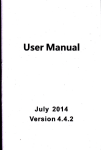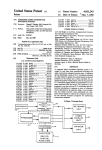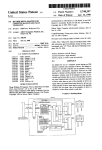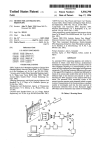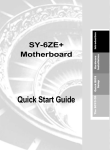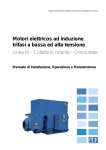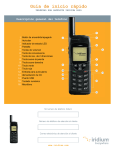Download IllillllllllllIllliilllllllllllllllllIlllllllllllllllllllllllllllllllllllll
Transcript
IllillllllllllIllliilllllllllllllllllIlllllllllllllllllllllllllllllllllllll
US005553294A
O
United States Patent [19]
[11] Patent Number:
Nanno et al.
[45]
[54]
Date of Patent:
PORTABLE COMPUTER POWERED BY
4,611,289
RECHARGEABLE BATTERIES
4,621,330
5,553,294
Sep. 3, 1996
9/1986 Coppola ................................ .. 364/492
11/1986 Weikel .............. ..
. 364/900
4,698,578 10/1987 Mullersman et a1.
[75]
Inventors:
Nobuyuki Nanno;
‘
- Kazuo
.
.
Akashi;
-_
,
Miyumi 0ka_ Atsuhiro O0take_ ’
’
’
James Mason; Yoshiaki Suzuki, all of
Tokyo, Japan
,
I?’
2/1989 Hirosawa et a1. ..
4,851,756
7/1989 Schaller et a1.
4,984,185
1/1991
5,148,042
5,239,495
9/1992 18282266 .... ..
8/1993 Nanno et a1.
5,270,946
Japan
[22]
Filed:
12/1993
.
Jun- 7, 1993
in“
364/707
307/60
364/707
Shibasaki et al. .................... .. 395/750
7/1988
European Pat. O?. .
European Pat. Off. 1
0335316
10/1989
European Pat. O?’. .
0340794 11/1989
European Pat. olr. .
12/1982
2226715
7/1990
[63] Continuation ofSer. N0. 718,359, Jun. 24, 1991, abandoned.
Foreign Application priority Data
395/750
.. 307/66
............. ..
0293664 12/1988
57-199979
Related US. Application Data
[30]
.-
FOREIGN PATENT DOCUMENTS
0273322
Appl. NO.: 72,689
S 't
307/66
. --------....... .,~-
4,809,163
[73] Assignee: Kabushiki Kaisha Toshiba, Kawasaki,
[21]
ar e
Japan .
United Kingdom .
OTHER PUBLICATIONS
Toshiba T1600 Portable Personal Computer User’s Manual,
(1988), ?rst edition, pp. 4-18 through 4-27.
Toshiba T1600 Portable Personal Computer User’s Manual,
[g] iapan ------------------------------- 25’ 1990
£6
12?:
Jun" 25’ 1990
Jun: 25: 1990
[JP]
[JP]
Jagan
" 2466211
Japan I: .............................. .2: 2-166212
" 2:166207
Chip Zeitschrift Fuer Mikrocomputer—Technik,No. 11,No'v.
1989, Wurlburg De, P‘ 29’ Computer deSJ-ahres
[51]
[52]
Int. c1.6 ................................ .. G06F 1/00; H02] 9/06
U s 01
............... .. 395/7507 364/707- 307/60-
Primary Exami'1er—G6°rg° _B- Davis
Am’mey’ Age“ 0’ Fi’mqmnegan’ Henderson’ Farah“,
[58]
Field of Search ........................... .. 395/750; 364/200,
364/707; 365/226, 229; 307/60, 66, 65,
157
307/65; 307/66; 307/157; 365/226; 365/229
[56]
References Cited
(1988), ?rst edition, pp. vi, vii, 4-27.
Gaffe“ & Dunner’ LLB
[57]
ABSTRACT
_
_
When a computer 18 not externally powered, 1t operates from
installed ?rst and second batteries. In top surface of the
computer, LEDs are provided which indicates three states of
each battery; need of charging, during charging, and comple
U.S. PATENT DOCUMENTS
4,315,162
[ion of charging
2/1982 Ferguson ............................... .. 365/229
4,365,290 12/1982 Nelms et al. ......................... .. 395/750
14 Claims, '18 Drawing Sheets
POWER ON ROUTINE
(WITH
AC ADAPTER)
UNCONNECTED
WHEN DRIVEN BY BATTERY
@144
HAS
OWER SWITCH BEE
DEPRESSED FOR PREDETE
PERIOD OF TIME ?
l.
m
r.
20
'2]
PRTCONT
24
25
5255356“ M u 7;
23
1192555595 u'l'L
ROM
AC
AC ADAPTER
29
'
HAS
L-BATTERY VOLTAGE
NECESSARY TO START
COMPUTER ’?
/
DISP
-CONT
VRAM
3,0
HAS
\
s24
1
.
R-BATTERY VOLTAGE\‘\ "0
NECESSARY TO START
mm]
KANJI ROM \
BACKUP
21 h z
TO POWER OFF
PROCESSING
ROUT'NE
KEYBOARD '36 3:5
..__ DICTIONARY
VBK
a —————— ~=
22
m
PIC
EXTHEENALWL
12.599“, 33
'
LTZLNlEPJ
34
0.
a,
INED
5
"1
”_ POWER SUPPLY _
_____ _,
COMPUTER 2
'
U.S. Patent
Sep.3, 1996
305
Sheet 2 of 18
5,553,294
30s
FL INVERTER
_}
30*
302
303
304
L2 LOW BATTERY (RED)
w, '_
° “38m
‘*‘T§~E
°—-c<f
5
L3 LOW BATTERY (RED)
$2
(.2 CHARGE (GREEN)
"*c: ————~L3 CHARGE (GREEN)
Q -————/———~DC-|N/DlSK—|N-USE/
°—~
COpS-LOCk/Num—LOCk/
l
Scroll
/,
3&9“ SE56“-
' MAIN CPU
PC
CP
s
306
A’
,
3H
= DC- | N \
(AC
’
CHARGER
Amp
3(3
sLI/,_3o9
C
SRO
3(00
A/D
35
L
V.
TL? 310%,’
SR1 \
3)e\
DC
05
C95
314
(.)>
02
O
U
2“
T:
3)).“1 I\3iR
342
/
3J6
CHARGER
35)?
.
l
I\3Ts
J,
DC-DC
CoNvERTER
VBK
US. Patent
Sep. 3, 1996
Sheet 3 of 18
5,553,294
C CHARGE CONTROL 3 (WITH AC ADAPTER CONNECTED)
TURN ON
DC IN LED
W81
R~BATTERY
MOUNTED ?
O
S8
53
L BATISTERY
NO
5
MOUNTED '?
>T
7
SL|=OFF SR|=ON
CHARGE R-BATTERY
S9
J
8,4
SR|=ON SR|=OFF
CHARGE L-BATTERY
R-BATTERY
=
.
EEE%%%)LXKYGEETHR%FEY
$0
LED (GREEN)
' L-BATTERY =
(YELLOW (s UGHTED)
TURN ON LOW-BATTERY
LED(RED)AND
CHARGE BATTERY LED
(GREEN)
(YELLOW (s L)GHTED)
$5
NO
RBATTERY
FULLY CHARGED ".P
SH
56
L-BAITSTERY
S
ULLY CHARGED ?>
R-BATTERY :
TURN OFF Low-BATTERY
HHRR’C HARGE
BATTERY (GREEN)
TURN OFF 5m “37
s(2
‘
)
L-BATTERY
=
TURN OFF LOW-BATTERY
LED (RED)
TURN ON CHARGE-BAT
TERY LED (GREEN)
s13“ TURN OFF SLI
FIG. 3
END
US. Patent
Sep. 3, 1996
Sheet 4 of 18
RoWER ON ROUTINE
5,553,294
(WITH
Ac ADAPTER)
UNCONNECTED
WHEN DRIVEN BY BATTERY
HAS
3-20
PoWER SWITCH BEEN
DEPRESSED FOR PREDETERMINED
NO
PERIOD OF TIME '?
TO POWER OFF
PROCESSING
ROUTINE
HAS
L-BATTERY VOLTAGE
NECESSARY TO START
COMPUTER '?
S23
S24
HAS
R-BATTERY VOLTAGE
NECESSARY TO START
COMPUTER ’?
TURN ON SRO
V825
(POWER ON) _
DC CIDNFLED
“S26
s27
-BATTERY ITSURNED ON .
NO E>
p—— YES
TURN ON CHARGE BATTERY LED “828
OF L-BATTERY
@
FIG. 4A
US. Patent
Sep.3, 1996
Sheet 5 of 18
5,553,294
IS
<L-BATTERY
IN
LOW-BATTERY
STATE ?
IS
R-BATTERY
MOUNTED ’?
l8
VOLTAGE OF R-BATTERY
NUGH ?
532
YES
NO
w;
'
839
5
L-BATTERY =
5
TURN ON 5R0
TURN OFF CHARGE BATTERY (GREEN)
FLICKER LOW BATTERY (RED)
L-BATTERY =
TURN OFF CHARGE BATTERY (GREEN) -s33
TURN ON LOW BATTERY (RED)
R-BATTERY =
TURN ON CHARGE BATTERY LED (GREEN)
i
334
/
IS
<R-BATTERY
IN
LOW-BATTERY
STATE '?
\
YES
E
U
S35
FIG. 4B
US. Patent
Sep. 3, 1996
Sheet 6 of 18
owm
5,553,294
w
o
P
w
m
n
z
d
21
\Em
H$E52IV
AM
OZ
wm
02
wm
w
m;
Tm>KoOnt
US. Patent
n3,3.32onNJ
Sep. 3, 1996
6380am88:884E32|_
\
v
V
v
q
K
\
A
N
E
~
K
v2x530835m:63)e:$3m
Sheet 7 of 18
5,553,294
“Hm_au<20Om5i2uNm/6zE<%o2u
8l|i_2wm.k6hzi?amo
32.5m
_2zo0w_Eo20$69zm.3i15é0"nm.20Sm“60E52M.9P52E1Q%05 a“z2QEom5Z?Gl06iE.”zwoQu;
“
m_
E
o
20
>
zo
5m
M
6
F
z
/
5
E
i
j
1
m
.
0
>
_n@QJ7IZ51E8M
3NJ
US. Patent
Sep. 3, 1996
Sheet 9 of 18
BATTERY PACK A
ram, 3m
FIG.7A
BATTERY PACK B
FIGTB
31L, 3"?
BATTERY PACK
PC MAIN BODY
FIG.7C
5,553,294
US. Patent
Sep. 3, 1996
Sheet 10 of 18
5,553,294
( BATTERY TYPE CHECK )
8‘
TS
BATTERY HIGH
CAPACITY SWITCH
ON ?
B2
N0
83
S
SET CHARGING DATA FOR
2200 01A TYPE BATTERY
CHARGE CONTROL
SET CHARGING DATA FOR
{700 [TIA TYPE BATTERY
U.S. Patent
Sep. 3, 1996
Q
'
'
‘ Sheet 11 of 18
5,553,294
j.
'
TO
age
9 SIGN |_
A9
A-—-—-—LDRIVER ——-_-_»-5
ENABLE
MEMORY CARD
Tb (iMB/2MB/4MB/8MB)
SEL
(
.
1
_
_ PC
F l G. 9
vcc
TC1- vcc
A8
vcc
TO“ A9
A8
A0
RAs
cAs
Rw
A0
RAs
CAS
Rw
D15
D15
b
D00
b
T - GND
00
R
T - SEL
W»
(END-L J
GND
iM/2M MEMORY CARD
4M/8M MEMORY CARD
FIG. 10A
FIG. 10B
I US. Patent
Sep.3, 1996
Sheet 12 of 18
FIGH
5,553,294
US. Patent
Sep. 3, 1996
Sheet 13 of 18
5,553,294
US. Patent
Sep. 3, 1996
Sheet 15 of 18
5,553,294
Remaining Battery capacity
<I_EFT>=
E
i??? F
<RIGHT>z
E ?'?'? F
speaker
Audible Battery
= m OFF
Wcrning=
Mode = @
RESUME
OFF
E
E
E
N/A
F
F
F
BATTERY MOUNT INITIAL STATE
BATTERY UNMOUNTED STATE
- BATTERY RESIDUAL CAPACITY
DISPLAY
FIG.I4
US. Patent
Sep. 3, 1996
Sheet 16 of 18
POWER ON ROUTINE
5,553,294
(WITH
AC ADAPTER)
UNCONNECTED
WHEN DRIVEN BY BATTERY
2/
S20
HAS
OWER SWITCH BEE
EPRESSED FOR PREDETERMINED
PERIOD OF TIME ?
YES
822
S2 I
NO
IS
9
To POWER OFF
PROCESSING
ROUTINE
>
YES
YES
HAS
-BAI IERY VOLTAG
NECESSARY TO START
COMPUTER ?
s23
YES
NO
' s24
HAS
R- BATTERY VOLTAGE
NO
NECESSARY TO START
OMPUTER 9
YES
TURN ON SRO
jszs
TURN
OFF SRO
(POWER ON)
“Iggy-D
U326
S27
IS
L- BATTERY TURNED ON
?
YES
TURN ON CHARGE BATTERY LED M828
OF L- BATTERY
E
0
FIG. 15A
US. Patent
Sep. 3, 1996
Sheet 17 of 18
IS
L-BATTERY IN
LOW-BATTERY STAT
NO
5,553,294
POWER
lS
R- BATTERY
MOUNTED ?
L- BATTERY =
TURN OFF CHARGE BATTERY
(GREEN)
TURN ON SRO
FLICKER LOW BATTERY(RED)
TURN OFF SRO
L-BATTERY
'
TURN OFF CHARGE BATTERY (GREEN) $833
TURN ON LOW BATTERY ( RED)
IS
E>___—.
PowERoN
?
R-BATTERY=
TURN ON CHARGE BATTERY LED (GREEN)
IS
R-BATTERY IN
NO
LOW — BATTERY STAT
?
YES
FIGJSB
5,553,294
1
2
PORTABLE COIVIPUTER POWERED BY
RECHARGEABLE BATTERIES
The foregoing objects are accomplished by a portable
computer powered by batteries, comprising: a ?rst recharge
able battery; a second rechargeable battery; operating power
This application is a continuation of application Ser. No.
07/718,359, ?led Jun. 24, 1991, now abandoned.
rechargeable batteries and for generating operating power
BACKGROUND OF THE INVENTION
battery; data processing means for performing data process
1. Field of the Invention
This invention relates to a portable computer powered by
rechargeable batteries, and more particularly to the method
generating means; checking means for checking the ?rst and
second batteries for discharged state; charging means for
charging the battery when the checking means judges that
the ?rst or second battery is in a discharged state that needs
charging; and informing means for informing the operator of
generating means for selecting one of the ?rst and second
from the output power from the selected ?rst or second
ing by using the operating power from the operating power
of charging and switching individual batteries and indicating
battery state in a portable computer.
2. Description of the Related Art
three states of the ?rst and second batteries, the three states
indicating need of charging, during charging, and comple
tion of charging.
with the above arrangement, this invention makes it
possible to judge without di?iculty that the individual bat
teries are fully charged, still being charged, or need charg
Computers powered by detachable batteries have been
developed. In this type of computer, the operator cannot tell
whether or not batteries are in the computer unless he checks
the battery compartment. Thus, an operator may be unaware
that only one battery is in a battery compartment that can
hold more than one battery. The single battery will then run
short earlier than expected, during operation, so that the
20
ing, which allows the operator to take proper measures if
necessary.
computer is forced to stop operation half way. Such mishaps
tend to occur with portable computers often powered by
batteries only, such as lap-top computers or book-type
(note-type) computers. These disadvantages of conventional
Additional objects and advantages of the invention will be
set forth in the description which follows, and in part will be
obvious from the description, or may be learned by practice
of the invention. The objects and advantages of the invention
portable computers prevent users from making full use of
the easy~to-carry feature.
Computers with a low-battery indicator are also available.
may be realized and obtained by means of the instrumen
talities and combinations particularly pointed out in the
For rechargeable batteries, however, the low-battery indica
tion cannot tell exactly the state of the battery. Further, it is
impossible to predict the remaining battery capacity, the
available computer operation time, and other factors unless
it is known whether the batteries are fully charged or still
being charged. Conventionally, however, there were no such
computers that automatically detected the charged/dis
charged state of the rechargeable batteries, and then
informed the operator of the results. Exact information on
the charged/discharged state is very helpful in making full
use of the features of portable computers often powered by
batteries only.
appended claims.
BRIEF DESCRIPTION OF THE DRAWINGS
The accompanying drawings, which are incorporated in
and constitute a part of the speci?cation, illustrate presently
preferred embodiments of the invention, and together with
the general description given above and the detailed descrip
tion of the preferred embodiments given below, serve to
explain the principles of the invention.
FIG. 1 is a block diagram showing an embodiment of a
personal computer according to the present invention;
FIG. 2 is a block diagram showing an arrangement of a
power supply circuit shown in FIG. 1:
FIG. 3 is a flow chart of a charge control routine executed
by a power control CPU 306 shown in FIG. 2;
Accordingly, an object of the present invention is to
FIGS. 4A, 4B and 4C are ?ow charts of a battery-driven
provide a computer capable of being powered by batteries 45 power-on routine executed by the power control CPU 306
which is easy to use.
shown in FIG. 2;
Another object of the present invention is to provide an
FIGS. 5A and 5B are views for explaining display con
easy-to-carry portable computer capable of being powered
tents of a state display unit in accordance with charge control
by detachable rechargeable batteries for a long-time opera
shown in FIG. 3;
tion, and of providing the operator with proper information
FIGS. 6A, 6B and 6C are views for explaining display
on the charged/discharged state of the individual batteries
contents of the state display unit in accordance with battery
and their installation, with a view to allowing full use of the
drivcn control shown in FIGS. 4A, 4B 4C;
easy-to-carry feature.
FIGS. 7A, 7B and 7C are views for explaining a type
Still another object of the present invention is to provide 55 detemiination mechanism of a mounted battery pack;
a portable computer capable of being operated from a
FIG. 8 is a ?ow chart showing a processing sequence of
plurality of batteries, which informs the operator of the
the power control CPU on the basis of the type determina
charged/discharged state of each battery to prevent problems
tion in FIG. 7;
including power shortage during operation, with the aim of
FIGS. 9, 10A and 10B are views for explaining an
allowing full use of the computer’s portability.
SUMMARY OF THE INVENTION
Still another object of the present invention is to provide
a portable computer capable of being operated from a
plurality of detachable batteries, which informs the operator
interface mechanism of a memory card used as an extension
RAM in the above embodiment;
FIGS. 11 and 12 and FIGS. 13A, 13B, 13C and 13D are
views for explaining a system grade-up means using a
whether or not the individual batteries are in place for easy
battery installation check to avoid problems including power 65 built-in HDD interface (HDD-IF) in the above embodiment;
FIG. 14 is a view showing a bottom-up menu for display
shortage during operation, for the purpose of enabling full
ing a battery state in the above embodiment; and
use of the computer’s portability.




























